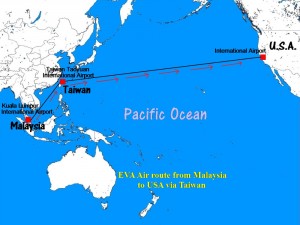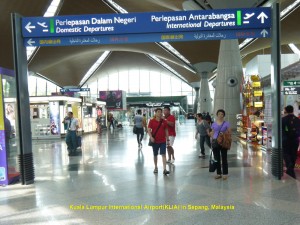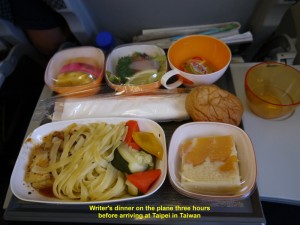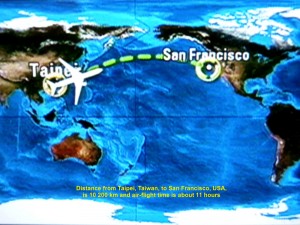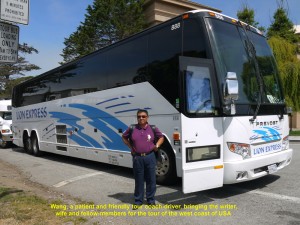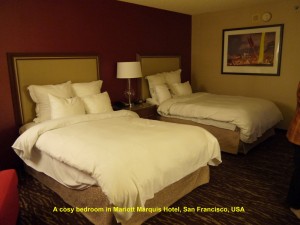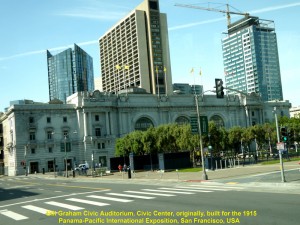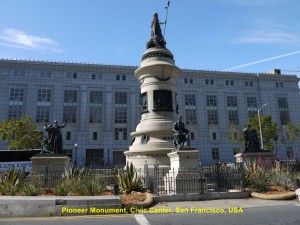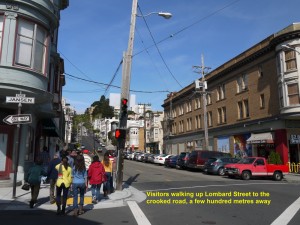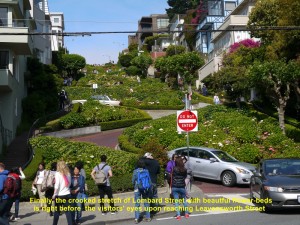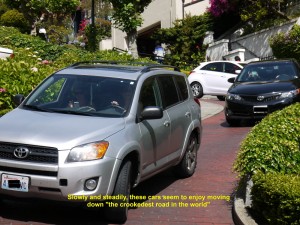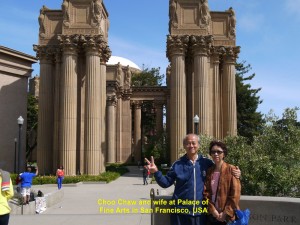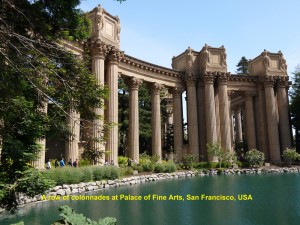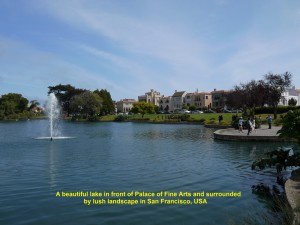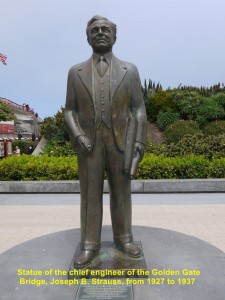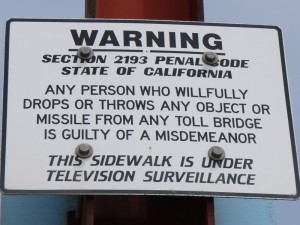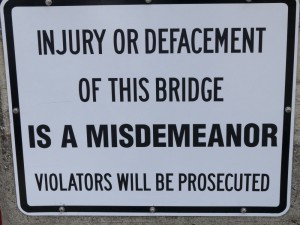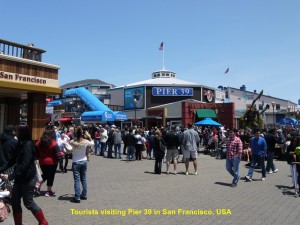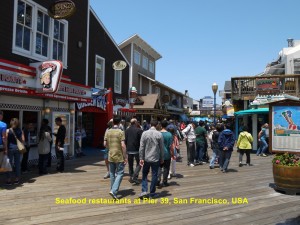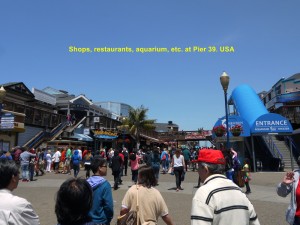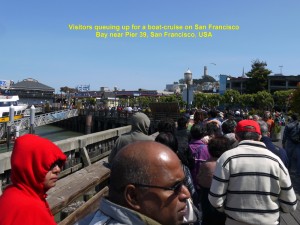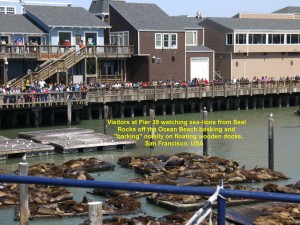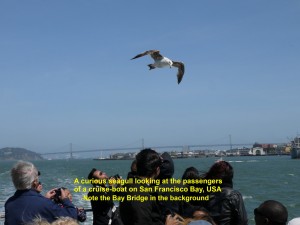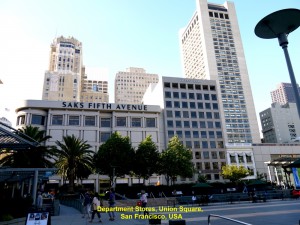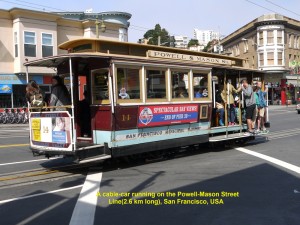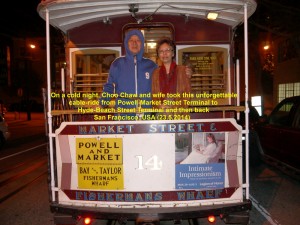USA West Coast Travel Part I (San Francisco City)
Filed under: USA, USA West Coast Travel Part I (San Francisco City)
USA West Coast Travel Part I (San Francisco City)
Day 1
23.5.2014
Travel to USA West Coast
For the first time, my wife and I were going to USA on 23.5.2014 for a short tour in its western region. We were going to visit several popular tourists’ places, like San Francisco City, Las Vegas, Los Angeles and Grand Canyon to name a few. We would spend about 11 days touring those places.
Departure from KLIA
On 23rd. May 2014, we went to Kuala Lumpur International Airport(KLIA) and joined a small group of Malaysian tourists under a capable guide, Jay Ho, from a travel agency, Travelcaya International Sdn. Bhd., in Kuala Lumpur.

Writer(L) and tour guide(R), Jay Ho, from Travelcaya International Sdn. Bhd., Kulala Lumpur at KLIA, Sepang, Malaysia

Writer and wife joining a USA West Coast tour planned by Travelcaya International Sdn. Bhd. in Kuala Lumpur, Malaysia
At 4.00 p.m. an Eva airline belonging to a Taiwanese company, EVA Airways Corporation, took off at KLIA and flew us straight to Taiwan Taoyuan International Airport in Taiwan. It took about 4 1/2 hours to arrive at the airport.
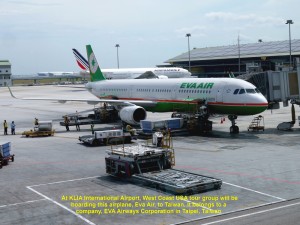
EVA Air, a plane belonging to EVA Airways Corporation of Taiwan at KLIA, is preparing to fly to Taiwan
Taiwan Taoyuan International Airport
At the airport we waited for another plane that would carry us to USA. After 4 hours of waiting, we, finally, resumed our journey to USA at 12.45 a.m. It would be a very long journey of about 10 200 km over the wide Pacific Ocean taking about 9 hours to reach San Francisco, our first destination in USA.
During that long hours of flight, I slept on and off, ate two meals, went to toilet two or three times, walked a few times on the aisle, watched a few movies and listened to some musics provided by the in-flight entertainment.
International Date Line
At 6.35 a.m.(Malaysia time) we crossed the International Date Line gaining a day, and five hours later we landed, safely, at the San Francisco International Airport, California, USA. Looking at my watch, it was 11.50 a.m.(Malaysia time). To follow the local time in San Francisco, I adjusted my watch to 8.50 p.m.(a difference of 15 hours).
Marriott Marquis Hotel, San Francisco City
At the airport immigration checkpoint, there was a long queue. We, patiently, waited for more than an hour before our passports were stamped by friendly officers. At 12 midnight we left the airport on a coach driven by Wang, an American. It brought us to a hotel, Marriott Marquis, located along Mission Street in the city centre. As the hotel rooms were large and the beds were comfortable, we had a good sleep throughout the night.
San Francisco is a vibrant city with a population of over 800 000. It is a cultural and financial hub in California. Besides, it has many places of attraction. On the following day, we were going to visit some of them.
Day 2
23.5.2014( Date and time in California, USA, will now be used.)
Day 2 in San Francisco was going to be very busy for all of us. We were going to visit several well-known places in the city. The following were the ones we visited.
Civic Centre
Civic Centre was the first place we visited. It is a place where the important government buildings and cultural institutions are located. Most of them are of neoclassical architecture, Beaux-Arts, that is taught in Paris, France.
Among them are City Hall(1915) for government offices, Bill Graham Civic Auditorium(1915) which is a multi-purpose arena, War Memorial Opera House(1932), Public(Main) Library and Asian Art Museum(1966) that houses a large collection of Asian art objects.
In an open area between the Public Library and Asian Art Museum, there is a monument, Pioneer Monument, which was a posthumous gift by a prominent and wealthy pioneer, James Lick(died in 1876) to the city-folks. It was built by a famous sculptor, Frank H. Happersberger(1859-1915).

Three gold prospectors in serious discussion in the “Early Days” at Pioneer Monument in Civic Centre, San Francisco
Pioneer Monument
In the centre of the monument is a high cylindrical, telescopic column with a statue of a Roman goddess, Minerva, atop. Surrounding its base are four white pedestals with life-size human statues: three gold prospectors of the “49” having a serious discussion on top of one of them, a padre talking to a native and a Mexican cowboy watching his cattle in the “Early Days” on another, a woman in a Roman dress holding a cornucopia on one more to show the importance of agriculture, and another woman in the same Roman dress holding an oar on the last one to show the importance of trade in the “Early Days”.

A padre talking to a native and Mexican cowboy watching his cattle at the Pioneer Monument in Civic Centre, San Francisco

Statue of a lady in Roman dress holding an oar, a symbol of the importance of commerce in the “Early Days” in USA
Civic Centre is a place where massive political rallies, civilians’ protests, festival parades, and other big events are usually held. A historic agreement was signed in 1945 in Hersbt Theatre in the War Memorial and Performing Arts Centre in Civic Centre, viz. “The UN Charter” that created “The United Nations”. An important treaty, “The Treaty of San Francisco”, was signed between Japan and Allied Powers at War Memorial Opera House in 1951 that, officially, ended the war with Japan.
Lombard Street
After the Civic Center visit, we went to see a short, steep stretch of Lombard Street which the local people claim it to be “the crookedest road in the world”. It is 180m long and has 8 hair-pin bends with well-kept flower-beds. Visitors can walk up about 250 steps on either side of it from Leavenworth Street to Hyde Street. Visitors may drive their cars down this winding road at a very low speed, 8 kph, as a challenge.
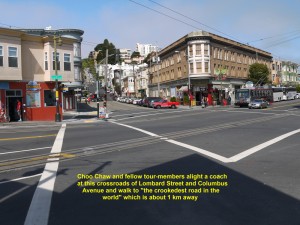
Crossroads of Lombard Street and Columbus Avenue where writer and others alight the coach and walk up Lombard Street, San Francisco
To see that unusual road, our coach left the Civic Centre and went to the crossroads of Lombard Street and Columbus Avenue where it stopped for us to alight. Then we walked up Lombard Street to the crooked stretch which was about a km away. As we were walking up further we saw houses in Victorian architechural style along the road that became steeper. Half an hour later, we reached the crossroads of Lombard Street and Leavenworth Street where the “the world’s crookedest” road began. As we were walking up over 200 steps on the right side of the crooked road, we saw beautiful and well-kept flower-beds beside it, and some cars moving down it, very slowly.
Scenery from Lombard and Hyde Crossroads
Soon we reached the end of the winding road at the crossroads of Lombard Street and Hyde Street. Standing at that crossroads and looking beyond the long Lombard Street, we saw a breathtaking view of Coit Tower, the skyline of the vibrant city and Bay Bridge. Standing at the same crossroads, but looking beyond and down Hyde Street, we saw another breathtaking view of the islands of Alcatraz and Angel and San Francisco Bay.
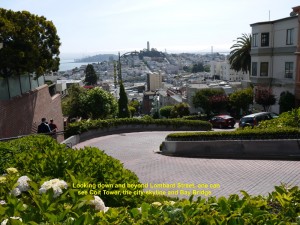
Breathtaking view of the crooked street of Lombard Street in the foreground and the city-skyline in the background, San Francisco, USA

Alcatraz Island and Angel Island in the distance as seen from the top of the crooked street of Lombard Street, San Francisco, USA
Several minutes later, we walked down Lombard Street with ease, and reached the crossroads where our coach that had been waiting for us at the same spot where we alighted earlier. We boarded the coach and left for another tourists’ spot, Palace of Fine Arts.
Palace of Fine Arts
After the interesting crooked part of Lombard Street visit, we went to see “Palace of Fine Arts” which is located along Lyon Street near San Francisco Bay. Bernard Maybeck(1862 – 1957), an architect, designed this beautiful Palace, a masterpiece, “to evoke the sadness and beauty of looking at a Roman ruin” and integrate the architecture and landscape of the place.
Panama-Pacific Expo
The Palace was built of wood and plaster to last a year for the 1915 Panama-Pacific Exposition(Expo). It had several rows of colonnades in a semi-circle and a large high rotunda in the middle. The structures were built in Roman and Greek architectural styles. A lake was created right in front of it in a lush surrounding.
After the Expo, that masterpiece was supposed to be demolished. Owing to the appeal to save the Palace for the enjoyment of future generations by Phoebe Apperson Hearst, only a part of it was preserved. But over many years the Palace deteriorated. In 1964 it was completely demolished . Later it was rebuilt with steel and cement to last a long time from generous public donations. Since then more improvements and restoration works were done. Now it looks grand and elegant in a scenic environment that attracts many tourists from near and far. Its serene and clean lake with trees round it attracts birds and racoons which make it their permanent home. Brides and grooms like to take photos together at this beautiful and romantic place.
The Golden Gate Bridge
After visiting Palace of Fine Arts, we went straight to San Francisco’s iconic landmark, the Golden Gate Bridge. It is 1 280 m long and ranks the world’s 12th. longest suspension bridge.
Chief Engineer
The chief engineer, Joseph B. Strauss, together with his large work-force took 4 years to construct and complete the bridge. It was built over the Golden Gate Strait that is 2 042 m wide connecting San Francisco Peninsula in the south and Marin County in the north. Completed in 1937, it was opened to traffic in the same year for the convenience of the inhabitants on both sides.
The bridge is painted in international orange, its signature colour, that makes it easily recognisable from a distance. It has two tall towers, each 227 m high, supporting long thick cables of diameter 92.4 cm with vertical suspenders that hold the road-deck. It is one of the world’s greatest modern engineering feats. The width of the bridge is 27.4 m that is taken up by six motor-lanes and two pedestrian-walkways.
Warning Notices
A few warning notices for drivers and pedestrians can be seen at strategic places on the bridge, e.g. “THE CONSEQUENCES OF JUMPING FROM THIS BRIDGE ARE FATAL AND TRAGIC”, “ANY PERSON WHO WILLFULLY DROPS OR THROWS ANY OBJECT OR MISSILE FROM ANY TOLL BRIDGE IS GUILTY OF MISDEMEANOR” and “INJURY OR DEFACEMENT OF THIS BRIDGE IS A MISDEMEANOR. VIOLATORS WILL BE PROSECUTED”
San Francisco Bay
From the bridge, visitors can see a spectacular panoramic view of San Francisco Bay, islands of Alcatraz and Angel, and the city skyline in the distance.
When we reached the bridge, our tour-coach brought us across it and then back making us feel excited and glad to have crossed that famous bridge in the world. Then it left us at the bridge to join the tourists from near and far to see the magnificent steel-structure and the breathtaking scenery of the bay, Alcatraz and Angel Islands and the city in the distance.
At 12.45 p.m. we left the bridge and went to another popular tourist spot, Pier 39 and Fisherman’s Wharf, about six km east of the bridge.
Fisherman’s Wharf and Pier 39
In the olden days between the mid and later 1800’s, Italian immigrants came to San Francisco and settled down in the Fisherman’s Wharf area. They became fishermen catching fish and crustaceans, especially Dungeness crabs in the Pacific Ocean, for the inhabitants in San Francisco city. Later, seafood restaurants were opened on Pier 39 near the wharf and attracted local people to dine on fresh seafood. Then shops selling souvenirs, apparels, fruits, etc. appeared there. Now Pier 39 has more attractions such as street-performances, carousel, aquarium, virtual 3-D rides, bungee-trampoline, etc. attracting more tourists.
Sea-Lions
At Pier 39, there is a colony of noisy sea-lions. Visitors will see them on floating wooden docks basking, comfortably, in the sun. They come from Seal Rocks which are off the Ocean Beach near Pier 39.
Bubba Gump Shrimp Co. Restaurant
When we arrived at Fisherman’s Wharf and Pier 39 at 1.30 p.m. we saw the place crowded with tourists. Then we headed straight to a food chain restaurant, Bubba Gump Shrimp Company Restaurant on the front of Pier 39 for lunch. This food-establishment was inspired by a 1994 movie, “Forrest Gump”. In this movie, Bubba suggested a shrimp-business. When Bubba died in Vietnam War(1955-1975), Forrest remembered Bubba’s suggestion and started a shrimp-business.
After lunch, we toured Pier 39 and Fisherman’s Wharf for a while. Then we walked to a ferry-terminal next to the pier and boarded a boat to cruise at San Francisco Bay at 3.15 p.m..
San Francisco Bay Boat Cruise
As soon as we were in the boat, it started to move to San Francisco Bay. As it was moving away from the terminal, slowly, we saw over 100 sea-lions on floating docks basking, comfortably, in the sun and tourists who were at Pier 39 watching them with curiosity and without caring for the smell from the animals.
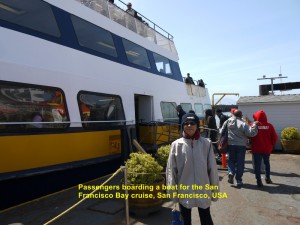
Passengers behind writer’s wife boarding a cruise-boat at a terminal next to Pier 39 in San Francisco, USA
Beautiful Sights
While the boat was cruising westwards at the large bay towards the Golden Gate Bridge, we could see beautiful sights of Fisherman’s Wharf, Pier 39, the city skyline and the Bay Bridge in the east. Then we passed an island, Alcatraz Island, which was notable for a federal prison for the most notorious criminals in USA. It was used from 1934 until 1963. Now it is a tourist attraction.
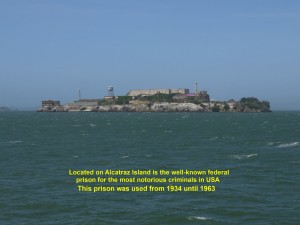
Alcatraz Island with a former federal prison for notorious criminals as seen from a cruise-boat at the Bay
Para-Surfers
As we sailed on, we saw a few para-surfers showing off their skills at the Bay. There was a moment when we were feeling amused to see two seagulls flying and following our boat, closely. for a few minutes.
Later, our boat slowed down when it was near San Francisco’s iconic bridge, Golden Gate Bridge. Then it went under it and made a U-turn to head back to the ferry-terminal. The long bridge was an awesome sight making my boat-cruise experience an unforgettable one.
Union Square
At 5 p.m. in the evening, Jay Ho, our tour-guide, walked us from our hotel to a public park, Union Square, which was a few streets away in the city-centre. The park got its name from Union Army as it was used as a venue for rallies and support for the army during the American Civil War(1861 – 1865). It is now a popular tourists’ place which is surrounded by shops that sell branded goods, theatres, art-galleries, department stores, restaurants, etc.
Dewey Monument
In the centre of Union Square stands a tall column with a statue of a lady holding a laurel wreath and trident atop. It is known as Dewey Monument erected by the Franciscans to commemorate the victory of the American Navy under Commodore George Dewey(1837 – 1917) at Manila Bay on 1st. May 1898 during the Spanish-American War.
Cable Car Ride
Cable cars are an icon in fascinating San Francisco City. They run on railway lines in the city but pulled by moving cables under the streets. The cables are continuously pulled by powerful electric motors in a power-house located between Washington and Jackson Streets.
A driver(or gripman) and a conductor work on a cable-car which can carry about 60 passengers. The fare for a single ride is USD6.00 and their top speed is about 15 kph. Besides, they can climb steep hills.
There were 23 lines in the period between 1873 and 1890, but now only 3 are left and in active operation, viz. Powell-Hyde Street Line(3,4 km), Powell-Mason Street Line(2.6 km) and California Street Line(2,3 km).
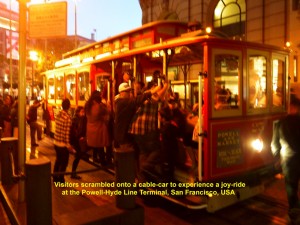
Visitors scrambling onto a cable-car to experience a ride at the Powell-Hyde Line Terminal, San Francisco City, USA
Now the cable-cars are mostly used by tourists as they find them antique, unique and fascinating, and a ride on it will be an unforgettable experience to them.
Cold Night
On a cold night of 23.5.2014, my wife and I could not resist a cable-car ride. We boarded one at the Powell-Market Terminal, paid USD6.00 and soon we were moving up Powell Street. Then we crossed the California Street Line, moved downhill, uphill again on Jackson Street, downhill again on Hyde Street and finally stopped at the Hyde-Beach Street Terminal. It was a wonderful feeling to have ridden on such a unique vehicle.
A few minutes later, we boarded another cable-car to return to the Powell-Market Terminal. That was truly a satisfying and memorable return cable-car ride.
(Continued in USA West Coast Travel Part II (San Francisco-Fresno-Las Vegas City))
Written by Choo Chaw, Kluang, Johor, Malaysia
U.S.A West Coast Travel:
Part II San Francisco, Fresno. Las Vegas
Part V Premium Outlets in S, California
Part VI Disneyland Resort, Anaheim
Part VII Hollywood Walk of Fame, Los Angeles

